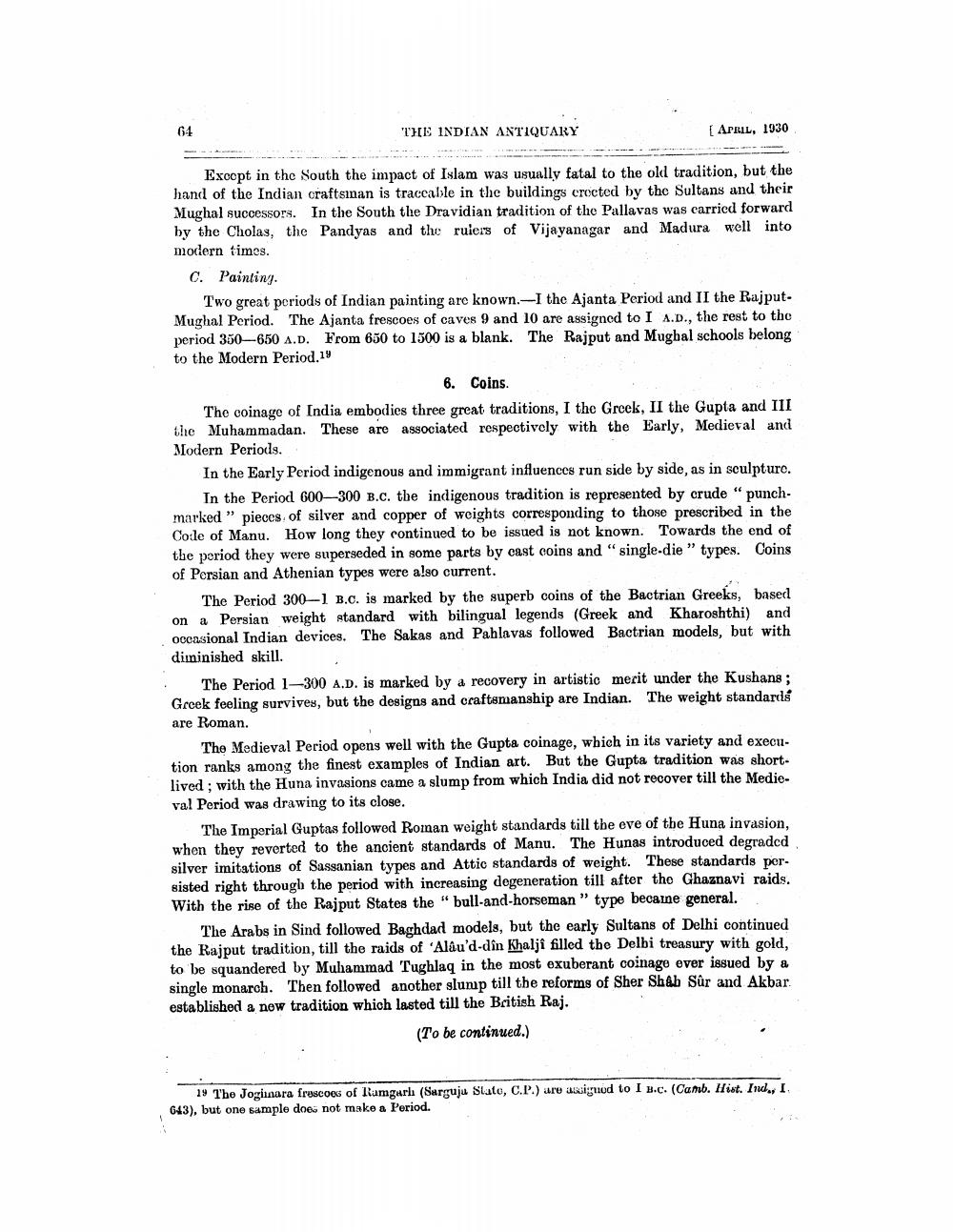________________
64
THE INDIAN ANTIQUARY
[ Arril, 1930
Except in the South the impact of Islam was usually fatal to the old tradition, but the hand of the Indian craftsinan is traccable in the buildings crocted by the Sultans and their Mughal successors. In the South the Dravidian tradition of the Pallavas was carried forward by the Cholas, the Pandyas and the rulers of Vijayanagar and Madura well into modern times. c. Painting.
Two great periods of Indian painting are known.--I the Ajanta Period and II the Rajput. Mughal Period. The Ajanta frescoes of caves 9 and 10 are assigned to I A.D., the rest to the period 350-650 A.D. From 650 to 1500 is a blank. The Rajput and Mughal schools belong to the Modern Period. 19
6. Coins. The coinage of India embodies three great traditions, I the Greek, II the Gupta and III the Muhammadan. These are associated respectively with the Early, Medieval and Modern Periods.
In the Early Period indigenous and immigrant influences run side by side, as in sculpture.
In the Period 600-300 B.C. the indigenous tradition is represented by crude "punchmarked " pieces of silver and copper of weights corresponding to those prescribed in the Cosle of Manu. How long they continued to be issued is not known. Towards the end of the period they were superseded in some parts by cast coins and "single-die" types. Coins of Persian and Athenian types were a!so current.
The Period 300-1 B.C. is marked by the superb coins of the Bactrian Greeks, based on a Persian weight standard with bilingual legends (Greek and Kharoshthi) and occasional Indian devices. The Sakas and Pahlavas followed Bactrian models, but with diminished skill.
The Period 1-300 A.D. is marked by a recovery in artistic merit under the Kushans ; Greek feeling survives, but the designs and craftsmanship are Indian. The weight standards are Roman.
The Medieval Period opens well with the Gupta coinage, which in its variety and execution ranks among the finest examples of Indian art. But the Gupta tradition was shortlived ; with the Huna invasions came a slump from which India did not recover till the Medieval Period was drawing to its close.
The Imperial Guptas followed Roman weight standards till the eve of the Huna invasion. when they reverted to the ancient standards of Manu. The Hunas introduced degraded silver imitations of Sassanian types and Attic standards of weight. These standards per. sisted right through the period with increasing degeneration till after the Ghaznavi raids. With the rise of the Rajput States the "bull-and-horseman " type becaine general.
The Arabs in Sind followed Baghdad models, but the early Sultans of Delhi continued the Rajput tradition, till the raids of 'Alau'd-dîn Khalji filled the Delbi treasury with gold, to be squandered by Muhammad Tughlaq in the most exuberant coinage ever issued by a single monarch. Then followed another slump till the reforms of Sher Shab Sur and Akbar established a now tradition which lasted till the British Raj.
(To be continued.)
19 The Jogiiara frescoes of Ramgarhi (Sarguju Slato, C.P.) are asiguod to I 3.c. (Camb. Hist. Ind., I. 643), but one sample does not make a Period.




